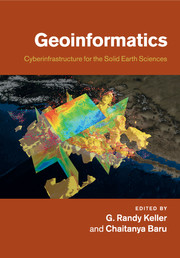Book contents
- Frontmatter
- Contents
- List of contributors
- Preface
- Introduction
- Part I Case studies from other disciplines
- Part II Modeling software and community codes
- Part III Visualization and data representation
- Part IV Knowledge management and data integration
- 10 Data and tools for geologic timelines and timescales
- 11 Modeling geodynamic processes with ontologies
- Part V Web services and scientific workflows
- Part VI Emerging international and other efforts
- Index
- Plate section
- References
10 - Data and tools for geologic timelines and timescales
from Part IV - Knowledge management and data integration
Published online by Cambridge University Press: 25 October 2011
- Frontmatter
- Contents
- List of contributors
- Preface
- Introduction
- Part I Case studies from other disciplines
- Part II Modeling software and community codes
- Part III Visualization and data representation
- Part IV Knowledge management and data integration
- 10 Data and tools for geologic timelines and timescales
- 11 Modeling geodynamic processes with ontologies
- Part V Web services and scientific workflows
- Part VI Emerging international and other efforts
- Index
- Plate section
- References
Summary
Introduction
Geologic timescales provide the vocabulary for geologic correlation, bring organization to the discussion of diverse processes and events, and enable the assembly of geologic history with global scope. Since the early attempts to calibrate a geologic timescale (Holmes, 1947; 1960), new stratigraphic techniques and radioisotopic systems have been brought to bear on the task; the volume of relevant information has increased dramatically; and the most recently published calibrations attempt finer resolution and explicit estimates of uncertainty (Gradstein et al., 2004). These trends have encouraged the use of statistical tools and custom databases that assemble local timelines of events and numerical ages, using the stratal thickness scales of measured sections and drill cores. These are the initial field and laboratory products that precede correlation, calibration, and statistical manipulations. Combining the local timelines into regional and global composites is a hard intellectual challenge. The named divisions of the geologic timescale are a much simpler conventional overlay upon these temporally integrated datasets. The application of state-of-the-art information technology and the optimization tools of operations research to large time-stratigraphic datasets introduces the possibility that timelines may be custom-built ‘on the fly’ from specific data queries and the user's choice of correlation algorithms. The print media and the labor of calibration tend to limit the familiar conventional geologic timescales to infrequent update and limited resolving power. This apparently stable nature tends to obscure many of the underlying uncertainties and assumptions of calibration.
- Type
- Chapter
- Information
- GeoinformaticsCyberinfrastructure for the Solid Earth Sciences, pp. 145 - 165Publisher: Cambridge University PressPrint publication year: 2011



